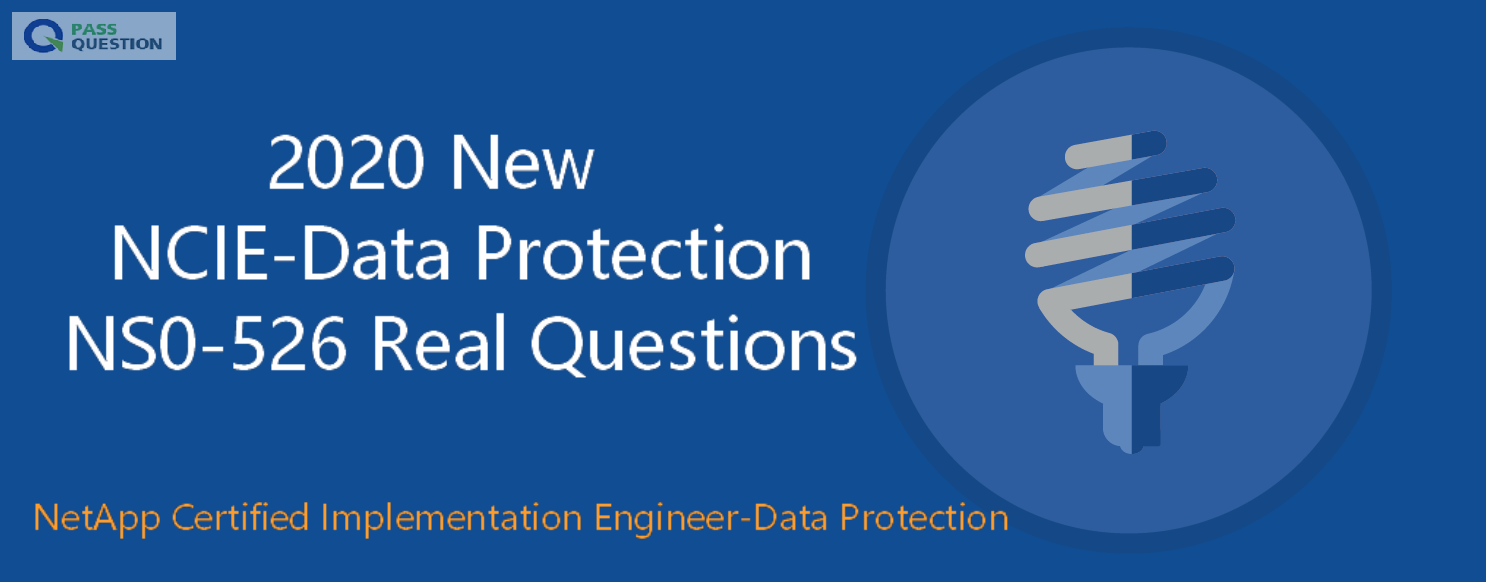2020 New NCIE-Data Protection NS0-526 Real Questions
If you want to pass NS0-526 NetApp Certified Implementation Engineer-Data Protection exam and get your NCIE-DP Certification, you must first achieve the NetApp Certified Data Administrator (NCDA) certification.PassQuestion NCIE-Data Protection NS0-526 Real Questions provide you an easy online solution to your NetApp NS0-526 exam Preparation. PassQuestion NS0-526 questions and answers provide all the exam objectives to help you write your test easily,PassQuestion guarantees your passing of NCIE-DP NS0-526 exam at your first try.

NCIE-Data Protection Certification NS0-526 Exam
NetApp Certified Implementation Engineer—Data Protection candidates have six to 12 months of experience with: NetApp ONTAP replication technology, planning and implementing data protection solutions, configuring backup and recovery software, operating backup and disaster recovery deployments.
The NS0-526 exam includes 60 test questions, with an allotted time of 1-1/2 hours to complete. In countries where English is not the native language, candidates for whom English is not their first language will be granted a 30-minute extension to the allotted examination completion time.
Exam Topics Covered In NS0-526 Exam
The NS0-526 exam includes the following topics:
NetApp Replication Technology
Describe how NetApp replication technology works.
Demonstrate how high-availability configurations work.
Describe the difference between synchronous and asynchronous replication.
Planning Data Protection Implementation
Describe data protection solutions.
Demonstrate how to apply guidelines and use NetApp tools.
Describe the implementation steps for application- and virtualization-specific workloads, including Snapshot retention policies.
Demonstrate how to develop a course of action to recover customer data after a disaster.
Describe how to implement security related to data protection.
Describe how to plan for Data Protection in the data fabric.
Configuring Data Protection Software
Describe how to configure SnapCenter, Snapshots, SnapMirror policies, or MetroCluster.
Describe which tool to use to set up and manage storage and schedule policies
Operating Data Protection Deployments
Demonstrate how to back up or restore data.
Demonstrate how to locate or protect unprotected volumes.
Describe how to use orchestratration for failover and failback application servers.
Describe how to monitor primary or secondary storage capacities.
Describe how to use external NetApp or third-party backup and recovery solutions.
Describe how to verify that backup and replication jobs are up-to-date.
Demonstrate how to validate that a backup can be restored.
Implementation Guidelines
Describe strategies for implementing NetApp data protection products in the data fabric.
Demonstrate how to calculate transfer time based on the customer's available bandwidth or latency distance for NetApp data protection products.
Describe storage efficiency for data protection.
Demonstrate automation policies for managing volume capacity.
Describe monitoring or reporting concepts.
View Online NetApp Certified Implementation Engineer-Data Protection NS0-526 Free Questions
1.Click the Exhibit button on the right.

Referring to the exhibit, which two tiers are monitored in the volume capacity? (Choose two)
A. performance
B. metadata
C. licensed
D. capacity
Answer: AD
2.You want to determine the amount of cold data that can be tiered from a FabricPool-enabled aggregate. In this scenario, which feature satisfies this requirement?
A. Information Lifecycle Management
B. Inactive Data Reporting
C. Auto Balance
D. Object Store Profiler
Answer: B
3.Your customer wants to implement SVM DR, but the customer is not certain whether the identity-preserve parameter should be enabled. The customer explains that the source and destination clusters are in different network subnets.
In this scenario, which SVM DR solution should the customer use?
A. SVM DR with the identity-preserve parameter enabled and a SnapMirror policy with the discard-configs network parameter.
B. SVM DR with the identity-preserve parameter enabled and the default SnapMirror policy.
C. SVM DR using the identity-preserve parameter enabled and then administratively take the data LIFs offline on the DR cluster.
D. SVM DR using the identity-preserve parameter disabled and the default SnapMirror policy.
Answer: B
4.You have created a new CIFS share but it is inaccessible. After verifying the export policy, network connectivity, junction path, and permissions are all correct, you realize there is root volume loadsharing mirror in place.
What should you do next to make the share accessible?
A. Update load-sharing mirror.
B. Update the root volume policy.
C. Re-create the CIFS share.
D. Modify the CIFS share permissions.
Answer: C
5.You must back up and replicate a Microsoft SQL server using SnapProtect in your clustered Data ONTAP environment.
Which three components must be correctly installed and configured? (Choose three.)
A. SnapProtect v10
B. SnapDrive for Windows
C. On Command Unified Manager 6.0
D. SnapProtect iDataAgent
E. On Command Workflow Automation
Answer: CDE
6.A customer has deployed OnCommand Unified Manager and wants to use it to manage their data protection relationships within their NetApp storage infrastructure.
In this scenario, which additional component must be deployed to satisfy this requirement?
A. OnCommand System Manager
B. OnCommand Cloud Manager
C. NetApp SnapCenter
D. OnCommand Workflow Automation
Answer: D
- TOP 50 Exam Questions
-
Exam
All copyrights reserved 2025 PassQuestion NETWORK CO.,LIMITED. All Rights Reserved.

